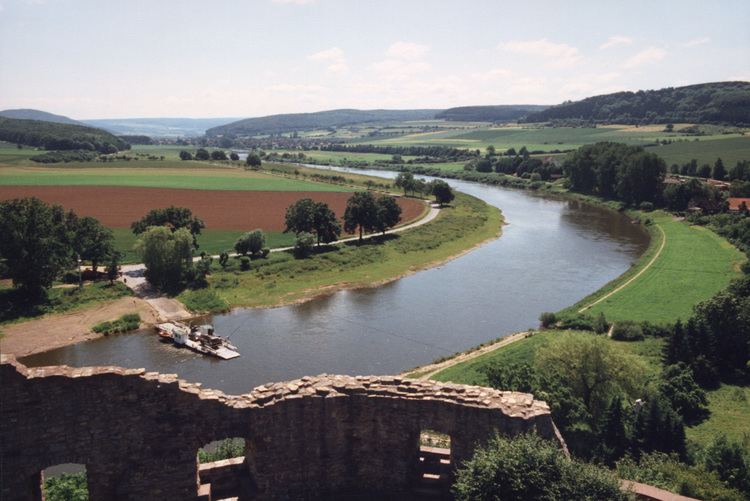- right Aller, Lesum - location Bremerhaven/Nordenham Length 452 km Sources Werra, Fulda Bridges Minden Aqueduct | - elevation 116 m (381 ft) - elevation 0 m (0 ft) Basin 46,306 km2 (17,879 sq mi) Mouths North Sea, Wadden Sea | |
 | ||
- left Diemel, Emmer, Werre, Große Aue, Hunte - location Confluence of the Fulda and Werra rivers in Hann. Münden Cities Bremen, Bremerhaven, Minden, Hamelin, Hann. Münden, Kassel Similar Elbe, North Sea, Weser Uplands, Aller, Steinhuder Meer | ||
Germany nienburg at the weser
The Weser ( [ˈveːzɐ]) is a river in Northwestern Germany. Formed at Hannoversch Münden by the confluence of the rivers Fulda and Werra, it flows through Lower Saxony, then reaching the Hanseatic-town Bremen (see: Hanseatic League), before emptying 50 kilometres (31 mi) further north at Bremerhaven into the North Sea. On the opposite (west) bank is the town of Nordenham at the foot of the Butjadingen Peninsula; thus, the mouth of the river is in Lower Saxony. The Weser has an overall length of 452 kilometres (281 mi). Together with its Werra tributary, which originates in Thuringia, its length is 744 kilometres (462 mi).
Contents
- Germany nienburg at the weser
- Map of Weser Germany
- 4k uhd relaxing video bremen germany weser stadtwerder inner city river boats
- Etymology
- Course
- Tributaries
- Left
- Right
- Notable towns
- References
Map of Weser, Germany
4k uhd relaxing video bremen germany weser stadtwerder inner city river boats
Etymology
Linguistically, the name of both rivers, Weser and Werra, goes back to the same source, the differentiation being caused by the old linguistic border between Upper and Lower German, which touched the region of Hannoversch Münden.
The name Weser parallels the names of other rivers, such as the Wear in England and the Vistula in Poland, all of which are ultimately derived from the root *weis- "to flow", which gave Old English/Old Frisian wāse "mud, ooze", Old Norse veisa "slime, stagnant pool", Dutch waas "lawn", Old Saxon waso "wet ground, mire", Old High German wasal "rain", and French vase "mud, sludge".
Course
The Weser river is the longest river whose course reaches the sea and lies entirely within German national territory.
The upper part of its course leads through a hilly region called the Weserbergland. It extends from the confluence of the Fulda and the Werra to the Porta Westfalica, where it runs through a gorge between two mountain chains, the Wiehengebirge in the west and the Weserbergland in the east.
Between Minden and the North Sea, humans have largely canalised the river, permitting ships of up to 1,200 tons to navigate it. Eight hydroelectric dams stand along its length. It is linked to the Dortmund-Ems Canal via the Coastal Canal, and another canal links it at Bremerhaven to the Elbe River. A large reservoir on the Eder river, the main tributary of the Fulda, is used to regulate water levels on the Weser so as to ensure adequate depth for shipping throughout the year. The dam, built in 1914, was bombed and severely damaged by British aircraft in May 1943, causing massive destruction and approximately 70 deaths downstream, but was rebuilt within four months. As of 2013 the Edersee reservoir, a major summer resort area, provides substantial hydroelectricity.
The Weser enters the North Sea in the southernmost part of the German Bight. In the North Sea, it splits up into two arms representing the ancient riverbed at the end of the last ice age. These sea-arms are called Alte Weser (old Weser) and Neue Weser (new Weser). They represent the major waterways for ships heading for the harbors of Bremerhaven, Nordenham and Bremen. The Alte Weser lighthouse marks the northernmost point of the Weser. This lighthouse replaced the historic and famous Roter Sand lighthouse in 1964.
Tributaries
The largest tributary of the Weser is the Aller, which joins south of Bremen. The tributaries of the Weser and the Werra (from source to mouth) are:
Left
Right
Notable towns
Towns along the Weser, from the confluence of Werra and Fulda to the mouth, include: Hann. Münden, Beverungen, Höxter, Holzminden, Bodenwerder, Hameln, Hessisch Oldendorf, Rinteln, Vlotho, Bad Oeynhausen, Porta Westfalica, Minden, Petershagen, Nienburg, Achim, Bremen, Brake, Nordenham, Bremerhaven.
